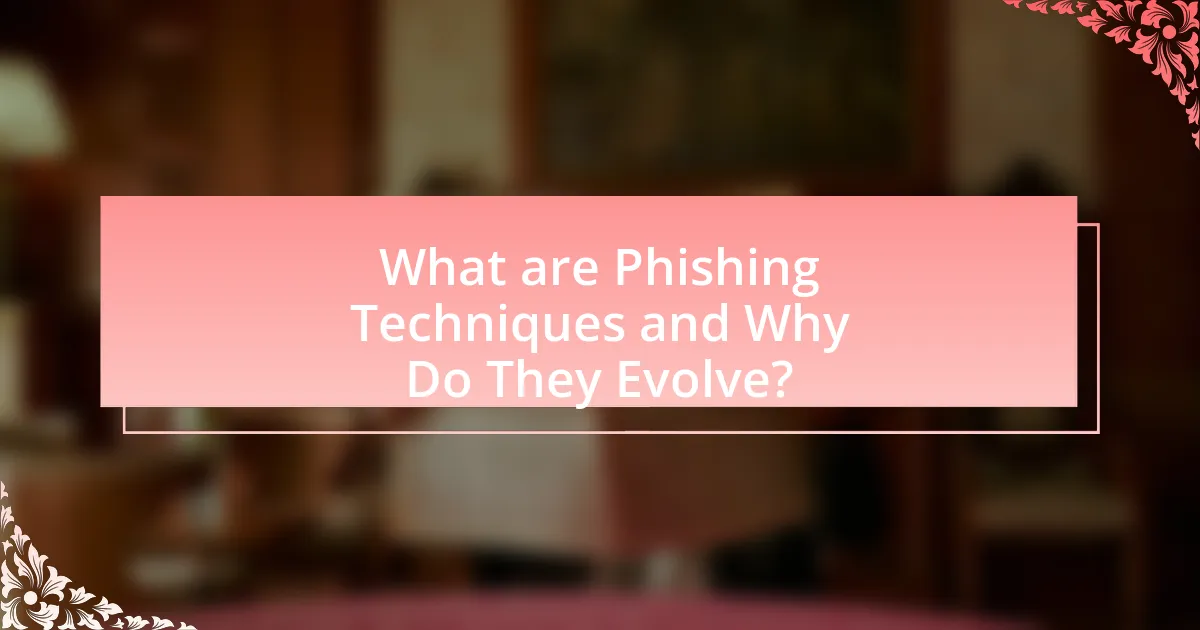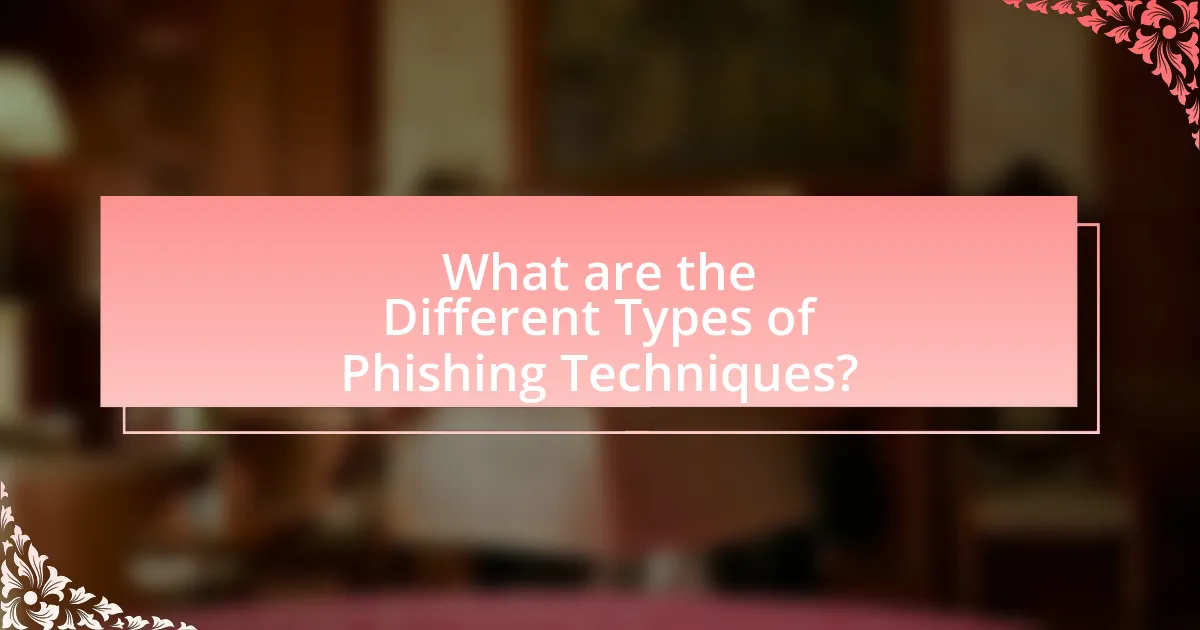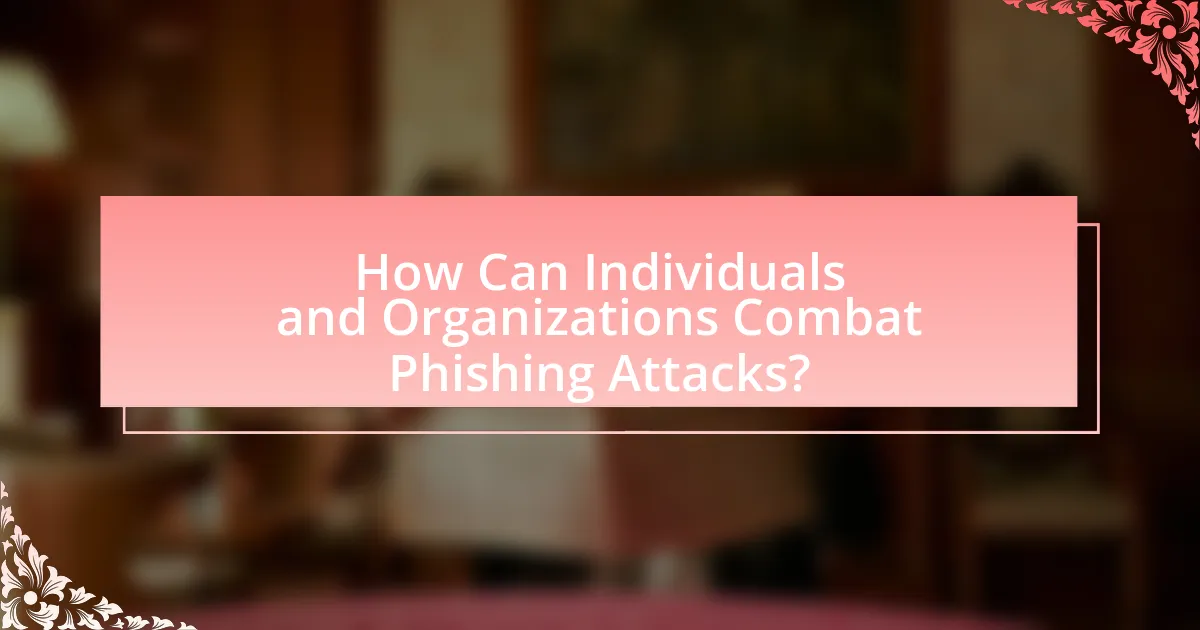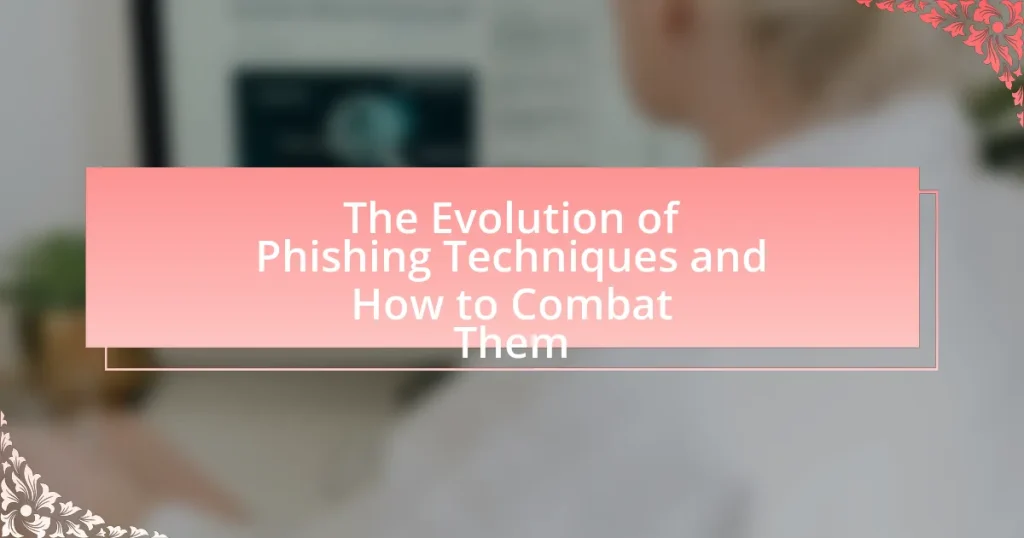Phishing techniques are deceptive methods employed by cybercriminals to extract sensitive information from individuals, evolving in response to technological advancements and changes in user behavior. This article explores the various types of phishing, including email phishing, spear phishing, vishing, and smishing, highlighting their reliance on social engineering tactics to manipulate victims. It also discusses the historical context of phishing, the impact of technological advancements, and the importance of understanding these evolving threats. Furthermore, the article outlines effective strategies for individuals and organizations to combat phishing attacks, including employee training, multi-factor authentication, and the implementation of cybersecurity frameworks.

What are Phishing Techniques and Why Do They Evolve?
Phishing techniques are deceptive methods used by cybercriminals to trick individuals into revealing sensitive information, such as passwords or credit card numbers. These techniques evolve due to advancements in technology, changes in user behavior, and the continuous adaptation of attackers to bypass security measures. For instance, traditional email phishing has expanded to include spear phishing, where attackers target specific individuals, and vishing, which involves voice calls to extract information. The evolution is also driven by the increasing sophistication of social engineering tactics, making it essential for users to stay informed and vigilant against emerging threats.
How do phishing techniques differ from other cyber threats?
Phishing techniques differ from other cyber threats primarily in their reliance on social engineering to deceive individuals into providing sensitive information. Unlike malware or ransomware, which typically exploit software vulnerabilities or encrypt files for ransom, phishing targets human psychology by creating a sense of urgency or trust. For example, a 2021 report by the Anti-Phishing Working Group indicated that phishing attacks accounted for 74% of all cybercrime incidents, highlighting their prevalence and unique approach compared to other threats that often focus on technical exploitation rather than manipulation of human behavior.
What are the key characteristics of phishing attacks?
Phishing attacks are characterized by deceptive communication aimed at tricking individuals into revealing sensitive information. These attacks often utilize emails, messages, or websites that appear legitimate but are designed to steal personal data such as passwords or credit card numbers. A key characteristic is the use of urgency or fear to prompt quick action from the victim, often leading to hasty decisions without proper verification. Additionally, phishing attacks frequently employ social engineering tactics, leveraging familiarity or authority to gain trust. According to the Anti-Phishing Working Group, there were over 200,000 reported phishing attacks in a single month in 2021, highlighting the prevalence and evolving nature of these threats.
Why is it important to understand the evolution of phishing?
Understanding the evolution of phishing is crucial because it enables individuals and organizations to recognize and mitigate increasingly sophisticated threats. Phishing techniques have evolved from simple email scams to complex schemes involving social engineering and advanced technology, such as spear phishing and whaling. For instance, according to the Anti-Phishing Working Group, the number of phishing attacks increased by 220% from 2020 to 2021, highlighting the need for awareness of these evolving tactics. By studying this evolution, stakeholders can develop more effective security measures, educate users about potential risks, and implement proactive strategies to combat phishing attacks.
What historical context led to the evolution of phishing techniques?
The historical context that led to the evolution of phishing techniques includes the rise of the internet in the 1990s and the increasing sophistication of online communication. As internet usage expanded, cybercriminals began exploiting the anonymity and accessibility of digital platforms to deceive users into revealing sensitive information. The term “phishing” originated in the mid-1990s when attackers used email to impersonate legitimate entities, such as banks, to lure victims into providing personal data. This method evolved with advancements in technology, including the development of social engineering tactics and the use of fake websites that closely mimic legitimate ones, reflecting a growing understanding of human psychology and trust dynamics in online interactions.
How did early phishing attacks operate?
Early phishing attacks operated primarily through deceptive emails that impersonated legitimate entities, such as banks or online services, to trick users into revealing sensitive information. These emails often contained urgent messages prompting recipients to click on malicious links leading to counterfeit websites designed to mimic authentic login pages. For instance, the first known phishing attack occurred in the mid-1990s, where attackers targeted AOL users by creating fake login pages to harvest usernames and passwords. This method exploited social engineering tactics, leveraging trust and urgency to manipulate victims into providing their credentials.
What technological advancements influenced phishing methods?
Technological advancements that influenced phishing methods include the rise of social media, mobile technology, and artificial intelligence. Social media platforms have enabled attackers to gather personal information, making phishing attempts more convincing and targeted. Mobile technology has facilitated phishing through SMS and app-based scams, allowing attackers to reach users directly on their devices. Artificial intelligence enhances phishing by automating the creation of realistic phishing emails and websites, increasing the likelihood of success. These advancements have made phishing more sophisticated and harder to detect, as evidenced by the increase in reported phishing incidents, which reached over 300,000 in 2020 alone, according to the Anti-Phishing Working Group.

What are the Different Types of Phishing Techniques?
Phishing techniques can be categorized into several types, including email phishing, spear phishing, whaling, vishing, and smishing. Email phishing involves sending fraudulent emails that appear to be from legitimate sources to trick users into providing sensitive information. Spear phishing targets specific individuals or organizations, often using personalized information to increase the likelihood of success. Whaling is a form of spear phishing that specifically targets high-profile individuals, such as executives, to gain access to sensitive data. Vishing, or voice phishing, uses phone calls to deceive individuals into revealing personal information, while smishing employs SMS text messages for similar purposes. According to the Anti-Phishing Working Group, these techniques have evolved significantly, with spear phishing accounting for a substantial percentage of reported phishing attacks in recent years.
How do traditional phishing attacks work?
Traditional phishing attacks work by deceiving individuals into providing sensitive information, such as usernames, passwords, or credit card details, through fraudulent communications that appear to be from legitimate sources. Attackers typically send emails or messages that mimic trusted entities, often including links to counterfeit websites designed to capture the victim’s data. According to the Anti-Phishing Working Group, in 2021, there were over 200,000 reported phishing attacks, highlighting the prevalence and effectiveness of this method.
What are the common tactics used in email phishing?
Common tactics used in email phishing include impersonation, urgency, and malicious links. Impersonation involves attackers posing as trusted entities, such as banks or well-known companies, to deceive recipients into providing sensitive information. Urgency is often employed by creating a false sense of immediacy, prompting users to act quickly without careful consideration, such as claiming an account will be suspended. Malicious links direct users to fraudulent websites designed to capture personal data. According to the Anti-Phishing Working Group, these tactics have contributed to a significant increase in phishing attacks, with over 200,000 reported incidents in a single month in 2021.
How do social engineering techniques enhance phishing effectiveness?
Social engineering techniques enhance phishing effectiveness by exploiting human psychology to manipulate individuals into divulging sensitive information. These techniques often involve creating a sense of urgency, authority, or familiarity, which increases the likelihood that targets will comply with the phishing attempt. For instance, a study by the Anti-Phishing Working Group found that phishing emails that invoke fear or urgency, such as warnings about account security, have significantly higher click-through rates. This demonstrates that social engineering tactics effectively lower the target’s defenses, making them more susceptible to fraudulent schemes.
What are the emerging phishing techniques in the digital age?
Emerging phishing techniques in the digital age include spear phishing, whaling, vishing, and smishing. Spear phishing targets specific individuals or organizations using personalized information to increase the likelihood of success, while whaling focuses on high-profile targets such as executives. Vishing, or voice phishing, involves fraudulent phone calls to extract sensitive information, and smishing uses SMS messages to lure victims into providing personal data. According to the 2023 Verizon Data Breach Investigations Report, phishing remains a leading cause of data breaches, highlighting the effectiveness of these techniques in exploiting human vulnerabilities.
How does spear phishing differ from general phishing?
Spear phishing differs from general phishing in that it targets specific individuals or organizations, rather than casting a wide net to reach many potential victims. Spear phishing attacks often involve personalized information about the target, making them more convincing and harder to detect. For example, a report by the Anti-Phishing Working Group indicates that spear phishing attacks have a higher success rate due to their tailored approach, which can include details such as the target’s name, job title, or recent activities. This specificity increases the likelihood that the target will engage with the malicious content, thereby enhancing the effectiveness of the attack.
What role do mobile devices play in modern phishing attacks?
Mobile devices are central to modern phishing attacks as they provide a convenient platform for attackers to reach users through SMS, email, and social media. The prevalence of mobile usage, with over 6 billion smartphone users globally, allows phishing attempts to exploit the immediacy and accessibility of mobile communication. Research indicates that 85% of phishing attacks now target mobile devices, leveraging techniques such as malicious links and fake app notifications to deceive users. This trend is further supported by the fact that mobile users are often less cautious than desktop users, increasing the likelihood of falling victim to these attacks.

How Can Individuals and Organizations Combat Phishing Attacks?
Individuals and organizations can combat phishing attacks by implementing robust cybersecurity measures, including employee training, email filtering, and multi-factor authentication. Employee training raises awareness about phishing tactics, enabling individuals to recognize suspicious emails and links. Email filtering systems can detect and block phishing attempts before they reach inboxes, significantly reducing exposure. Multi-factor authentication adds an additional layer of security, making it more difficult for attackers to gain unauthorized access even if credentials are compromised. According to the Anti-Phishing Working Group, organizations that adopt these strategies can reduce the risk of successful phishing attacks by up to 70%.
What preventive measures can be taken against phishing?
To prevent phishing, individuals and organizations should implement multi-factor authentication (MFA), which adds an extra layer of security beyond just passwords. MFA significantly reduces the risk of unauthorized access, as it requires users to provide two or more verification factors to gain access to their accounts. According to a study by Microsoft, enabling MFA can block over 99.9% of automated attacks, demonstrating its effectiveness in combating phishing attempts. Additionally, regular employee training on recognizing phishing attempts and the use of email filtering tools can further enhance security measures against phishing threats.
How can awareness and training reduce phishing risks?
Awareness and training can significantly reduce phishing risks by equipping individuals with the knowledge to recognize and respond to phishing attempts. When employees undergo training programs that focus on identifying suspicious emails, understanding common phishing tactics, and practicing safe online behaviors, they become less likely to fall victim to these scams. For instance, a study by the Ponemon Institute found that organizations with regular security awareness training experienced a 70% reduction in phishing susceptibility. This demonstrates that informed individuals are more vigilant and capable of detecting fraudulent communications, thereby minimizing the likelihood of successful phishing attacks.
What technological solutions are available to combat phishing?
Technological solutions available to combat phishing include email filtering, multi-factor authentication (MFA), and anti-phishing software. Email filtering uses algorithms to detect and block phishing attempts by analyzing email content and sender reputation, significantly reducing the likelihood of users encountering malicious emails. Multi-factor authentication adds an extra layer of security by requiring users to provide two or more verification factors, making it more difficult for attackers to gain unauthorized access even if they obtain a user’s password. Anti-phishing software actively scans websites and emails for known phishing threats, alerting users before they interact with potentially harmful content. These solutions have been shown to decrease phishing success rates, with studies indicating that organizations implementing MFA can reduce account compromise by up to 99.9%.
What are the best practices for recognizing phishing attempts?
The best practices for recognizing phishing attempts include scrutinizing email addresses, checking for spelling errors, and verifying links before clicking. Phishing emails often use addresses that mimic legitimate sources but contain slight variations, such as misspellings or unusual domains. Additionally, many phishing attempts contain grammatical mistakes or awkward phrasing, which can indicate a lack of professionalism. Users should hover over links to see the actual URL before clicking, as phishing links often redirect to malicious sites. According to the Anti-Phishing Working Group, in 2022, 83% of phishing attacks used email as the delivery method, highlighting the importance of vigilance in email communications.
How can users identify suspicious emails and messages?
Users can identify suspicious emails and messages by examining several key indicators. First, they should look for unusual sender addresses that do not match the organization’s official domain, as phishing attempts often use slight variations of legitimate addresses. Additionally, users should be cautious of generic greetings, such as “Dear Customer,” which are commonly used in phishing scams.
Another red flag is the presence of urgent language or threats, prompting immediate action, which is a tactic used to create panic. Users should also scrutinize any links or attachments, as these may lead to malicious websites or contain harmful software. Hovering over links without clicking can reveal the actual URL, helping users verify its legitimacy.
Furthermore, spelling and grammatical errors are often prevalent in phishing messages, indicating a lack of professionalism. According to the Anti-Phishing Working Group, over 80% of phishing emails contain such errors, making this a reliable indicator. By being vigilant about these signs, users can better protect themselves from falling victim to phishing attacks.
What steps should be taken if a phishing attempt is suspected?
If a phishing attempt is suspected, the immediate step is to cease all interaction with the suspicious communication. This includes not clicking on any links or downloading attachments. Next, report the phishing attempt to the relevant authorities, such as your organization’s IT department or a cybersecurity agency, to help mitigate further risks. Additionally, it is crucial to change passwords for any accounts that may have been compromised and enable two-factor authentication where possible. According to the Anti-Phishing Working Group, reporting phishing attempts can significantly reduce the effectiveness of such attacks, as it helps in tracking and shutting down malicious sites.
What resources are available for ongoing education about phishing?
Ongoing education about phishing is supported by various resources, including online courses, webinars, and educational websites. Organizations like the Anti-Phishing Working Group (APWG) provide comprehensive resources and updates on phishing trends. Additionally, platforms such as Coursera and Udemy offer courses specifically focused on cybersecurity and phishing awareness. The Federal Trade Commission (FTC) also provides educational materials and guidelines on recognizing and avoiding phishing scams. These resources are essential for staying informed about evolving phishing techniques and effective countermeasures.
How can organizations stay updated on phishing trends and tactics?
Organizations can stay updated on phishing trends and tactics by subscribing to cybersecurity threat intelligence services and participating in industry forums. These services provide real-time updates on emerging phishing techniques, while forums facilitate knowledge sharing among professionals. For instance, the Anti-Phishing Working Group (APWG) regularly publishes reports detailing phishing trends, which can serve as a valuable resource for organizations. Additionally, attending cybersecurity conferences and training sessions helps organizations learn about the latest phishing tactics directly from experts in the field.
What role do cybersecurity frameworks play in combating phishing?
Cybersecurity frameworks play a crucial role in combating phishing by providing structured guidelines and best practices for organizations to enhance their security posture. These frameworks, such as the NIST Cybersecurity Framework and ISO/IEC 27001, help organizations identify vulnerabilities, implement effective security controls, and establish incident response protocols specifically tailored to address phishing threats. For instance, the NIST framework emphasizes risk assessment and continuous monitoring, which are essential for detecting and mitigating phishing attempts. By adhering to these frameworks, organizations can significantly reduce the likelihood of successful phishing attacks, as evidenced by studies showing that organizations implementing such frameworks experience fewer security incidents.
What practical tips can help individuals avoid falling victim to phishing?
To avoid falling victim to phishing, individuals should verify the sender’s email address before clicking on any links or downloading attachments. Phishing attacks often use deceptive email addresses that closely resemble legitimate ones, making it crucial to check for slight variations. Additionally, individuals should enable two-factor authentication on their accounts, as this adds an extra layer of security that can prevent unauthorized access even if login credentials are compromised. Regularly updating software and security systems is also essential, as these updates often include patches for vulnerabilities that phishing attacks exploit. According to the Anti-Phishing Working Group, in 2021, 83% of phishing attacks were conducted via email, highlighting the importance of vigilance in email communications.


